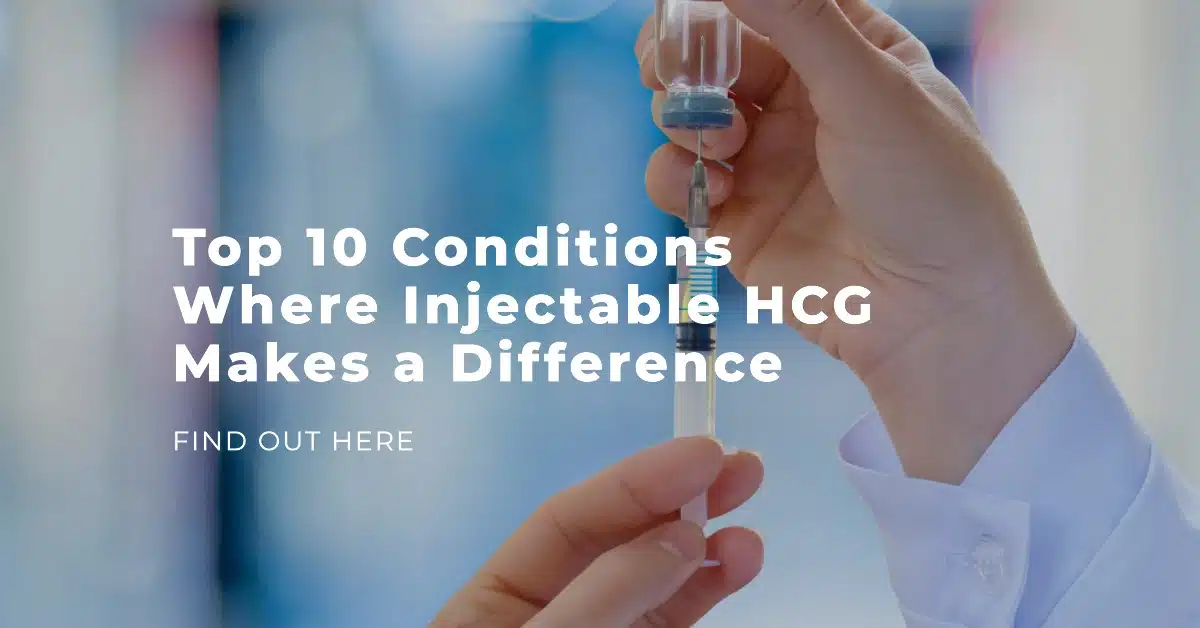Pumping Up Testosterone: The Pregnancy Puzzle
Testosterone Replacement Therapy (TRT) has become increasingly popular among men seeking to address symptoms of low testosterone. However, for those considering starting a family, a crucial question arises: Can you get someone pregnant while on TRT? This article delves into the complex relationship between TRT and male fertility, providing you with the information you need to make informed decisions about your health and family planning goals.
Before we dive deeper, let’s look at some intriguing facts about TRT and fertility:
- Studies show that TRT can lead to a decrease in sperm count and motility, potentially impacting fertility source.
- The infertility caused by TRT is usually temporary and reversible by stopping testosterone administration source.
- Alternative treatments like clomiphene citrate and HCG therapy can help support testosterone production without significantly affecting sperm count source.
Source: Journal of Urology study, as mentioned in the article
Understanding Testosterone Replacement Therapy (TRT)
What is TRT and Why Do Men Use It?
Testosterone Replacement Therapy (TRT) is a medical treatment designed to address low testosterone levels in men. Testosterone, often called the “male hormone,” plays a crucial role in various bodily functions, including muscle mass maintenance, bone density, sex drive, and overall energy levels.
As men age, it’s natural for testosterone levels to decline. However, some men experience a more significant drop, leading to symptoms that can impact their quality of life. This condition, known as hypogonadism or “low T,” prompts many to seek TRT as a solution.
Common Methods of TRT Administration
TRT comes in various forms, each with its own advantages and considerations:
- Injections: Testosterone injections deliver the hormone directly into the muscle, typically every one to two weeks. This method allows for precise dosing but can lead to fluctuations in hormone levels between injections.
- Gels: Testosterone gels are applied daily to the skin, providing a steady release of the hormone. While convenient, care must be taken to avoid transferring the gel to others through skin contact.
- Patches: Similar to gels, testosterone patches are applied to the skin daily. They offer a consistent hormone release but may cause skin irritation in some users.
- Pellets: Tiny pellets containing testosterone are surgically implanted under the skin, releasing the hormone over several months. This method requires fewer treatments but involves a minor surgical procedure.
Symptoms of Low Testosterone
Men experiencing low testosterone levels may notice a range of symptoms, including:
- Decreased libido
- Erectile dysfunction
- Fatigue and low energy levels
- Reduced muscle mass and strength
- Increased body fat, particularly around the midsection
- Mood changes, including irritability and depression
- Difficulty concentrating
- Decreased bone density
It’s important to note that these symptoms can also be caused by other health conditions. A proper diagnosis from a healthcare provider is essential before starting TRT.
The Impact of TRT on Male Fertility
How TRT Affects Sperm Production
While TRT can effectively alleviate symptoms of low testosterone, it can also have a significant impact on male fertility. To understand this effect, we need to look at the body’s natural testosterone production process.
Under normal circumstances, the hypothalamus in the brain signals the pituitary gland to produce luteinizing hormone (LH) and follicle-stimulating hormone (FSH). LH stimulates the testes to produce testosterone, while FSH promotes sperm production. This delicate balance is known as the hypothalamic-pituitary-gonadal (HPG) axis.

When external testosterone is introduced through TRT, the body detects higher levels of the hormone in the bloodstream. As a result, the hypothalamus reduces its signaling, leading to decreased production of LH and FSH. This disruption of the HPG axis can significantly impact sperm production.
Evidence from Studies
Research has consistently shown that TRT can lead to a decrease in sperm count and motility. A study published in the Journal of Urology found that men on TRT experienced a significant reduction in sperm concentration, with some becoming azoospermic (having no sperm in their semen) within 6-12 months of treatment.
Another comprehensive review of multiple studies concluded that TRT resulted in a 50-70% decrease in sperm production in most men. This reduction can significantly impact fertility, making it more challenging to conceive naturally.
Hormonal Mechanisms at Play
The suppression of the HPG axis by exogenous testosterone affects not only sperm production but also the overall testicular environment. Intratesticular testosterone levels, which are crucial for optimal sperm development, can decrease dramatically during TRT.
Moreover, the reduction in FSH levels can lead to a decrease in Sertoli cell function. Sertoli cells play a vital role in nurturing and supporting developing sperm cells. When their function is impaired, it can result in lower sperm quality and quantity.
Is It Possible for Men on TRT to Have Children?
Conception Challenges for Men on TRT
While it’s not impossible for men on TRT to father children, the treatment does present significant challenges to fertility. The reduced sperm count and quality resulting from TRT can make natural conception more difficult.
It’s important to understand that fertility is a complex issue, and individual responses to TRT can vary. Some men may retain enough sperm production to achieve pregnancy, while others may experience a more severe impact on their fertility.
Fertility Outcomes: TRT vs. No Treatment
Studies comparing fertility outcomes between men on TRT and those not receiving treatment have shown notable differences. A large-scale study published in the New England Journal of Medicine found that men with untreated hypogonadism had pregnancy rates of about 50% over a 12-month period. In contrast, men receiving TRT had significantly lower pregnancy rates, ranging from 20-30% over the same period.
These statistics highlight the potential impact of TRT on fertility. However, it’s crucial to remember that individual cases can vary, and factors such as age, overall health, and the specific TRT regimen can influence outcomes.
Reversibility of TRT-Induced Infertility
Can Fertility Return After Stopping TRT?
One of the most pressing questions for men considering TRT is whether the potential infertility is permanent. The good news is that in most cases, TRT-induced infertility is reversible.
When TRT is discontinued, the body’s natural testosterone production typically resumes. This process, known as recovery of endogenous testosterone production, allows the HPG axis to reactivate, stimulating both testosterone and sperm production.
Timeline for Fertility Recovery
The timeline for fertility recovery can vary significantly among individuals. Some men may see a return to normal sperm production within a few months of stopping TRT, while others may take longer.
A study published in the International Journal of Andrology found that most men experienced a return to baseline sperm concentrations within 6-12 months after discontinuing TRT. However, some men required up to 24 months for full recovery.
Factors Influencing Recovery
Several factors can influence the speed and extent of fertility recovery after TRT:
- Duration of TRT: Generally, the longer a man has been on TRT, the longer it may take for fertility to recover.
- Age: Younger men tend to recover fertility more quickly than older men.
- Pre-TRT fertility status: Men who had normal fertility before starting TRT may recover more easily than those who had pre-existing fertility issues.
- Type and dosage of TRT: Different forms of testosterone and dosages may impact recovery time.
- Individual physiology: Each man’s body may respond differently to the cessation of TRT.
It’s crucial for men considering stopping TRT to boost fertility to work closely with their healthcare provider. In some cases, additional treatments may be recommended to help stimulate natural testosterone and sperm production.
Alternatives to TRT for Maintaining Fertility
Fertility-Preserving Options for Men with Low Testosterone
For men who want to address low testosterone symptoms while maintaining their fertility, several alternatives to traditional TRT are available. These options aim to stimulate the body’s natural testosterone production without suppressing sperm production.
- Clomiphene Citrate (Clomid)
Clomiphene citrate, commonly known as Clomid, is a selective estrogen receptor modulator (SERM) that can help increase testosterone levels without negatively impacting sperm production. It works by blocking estrogen receptors in the hypothalamus, which leads to increased production of LH and FSH, stimulating both testosterone and sperm production.
Clomid is typically taken orally and has been shown to effectively raise testosterone levels in many men. It’s often considered a first-line treatment for men with low testosterone who want to preserve their fertility.
- Human Chorionic Gonadotropin (hCG)
Human Chorionic Gonadotropin (hCG) is a hormone that mimics the action of LH in the body. When administered, it stimulates the testes to produce testosterone and maintain sperm production. hCG is usually given as an injection and can be used alone or in combination with other treatments.
hCG therapy can be particularly beneficial for men who have experienced testicular shrinkage due to long-term TRT use, as it can help restore testicular size and function.
- Enclomiphene Citrate
Enclomiphene citrate is a newer medication that works similarly to clomiphene citrate but with potentially fewer side effects. It selectively increases FSH and LH production, leading to increased testosterone levels while maintaining sperm production.
While not yet as widely used as clomiphene citrate, enclomiphene shows promise as a fertility-preserving option for men with low testosterone.
Benefits of Alternative Treatments
These alternative treatments offer several advantages for men concerned about their fertility:
- Maintained Sperm Production: Unlike traditional TRT, these treatments stimulate the body’s natural testosterone production without suppressing sperm production.
- Reversibility: If fertility is no longer a concern, men can easily transition to traditional TRT if needed.
- Customization: Treatment can be tailored to individual needs and adjusted based on response.
- Potential for Natural Conception: By maintaining sperm production, these treatments allow for the possibility of natural conception.
It’s important to note that while these alternatives can be effective, they may not be suitable for all men. Some individuals may not respond well to these treatments or may experience side effects. Always consult with a healthcare provider to determine the best course of action for your specific situation.
Considerations for Men Planning to Start TRT
Discussing Fertility Goals with Healthcare Providers
If you’re considering TRT but are also planning to start or expand your family, it’s crucial to have an open and honest discussion with your healthcare provider. Here are some key points to address:
- Current Fertility Status: Your doctor may recommend a semen analysis to assess your baseline fertility before starting any treatment.
- Family Planning Timeline: Discuss your plans for having children, both in the near future and long-term.
- Treatment Options: Explore all available options, including TRT alternatives that may help preserve fertility.
- Potential Risks: Understand the possible impact of TRT on your fertility and discuss strategies to mitigate these risks.
- Monitoring Plan: Establish a plan for regular check-ups to monitor both testosterone levels and fertility parameters.
Recommendations for Baseline Testing and Sperm Banking
Before starting TRT, your healthcare provider may recommend several baseline tests:
- Hormone Panel: This will assess your current testosterone levels, as well as other related hormones like LH, FSH, and estradiol.
- Semen Analysis: This test evaluates sperm count, motility, and morphology, providing a comprehensive picture of your current fertility status.
- Physical Examination: Your doctor may perform a testicular exam and check for any signs of underlying health issues that could be affecting your testosterone levels.
For men who are certain they want to have children in the future but also need to start TRT, sperm banking is an important consideration. This process involves freezing and storing sperm for future use in assisted reproductive techniques like in vitro fertilization (IVF) or intrauterine insemination (IUI).
Sperm banking offers several advantages:
- Fertility Preservation: It provides a backup option if TRT significantly impacts your fertility.
- Peace of Mind: Knowing you have sperm stored can reduce anxiety about future family planning.
- Flexibility: It allows you to start TRT to address your symptoms while keeping your reproductive options open.
Conclusion
Navigating the complex relationship between TRT and fertility requires careful consideration and professional guidance. While TRT can effectively address symptoms of low testosterone, it can also significantly impact male fertility. The good news is that this impact is often temporary and reversible.
For men concerned about maintaining their fertility while addressing low testosterone symptoms, several alternatives to traditional TRT are available. These options, such as clomiphene citrate, hCG, and enclomiphene citrate, can help boost testosterone levels without suppressing sperm production.
Ultimately, the decision to start TRT should be made in consultation with a healthcare provider, taking into account your individual health needs, fertility goals, and family planning timeline. By staying informed and proactive, you can make the best choices for your health and future.
Remember, every individual’s situation is unique. What works for one person may not be the best solution for another. Always seek personalized medical advice and don’t hesitate to ask questions or voice concerns about your treatment options.
FAQ
Can a man on TRT get a woman pregnant?
Yes, it’s possible but more difficult. TRT typically reduces sperm count and quality, lowering the chances of natural conception.
How fertile are men on TRT?
Men on TRT often experience reduced fertility due to decreased sperm production. The extent varies, with some becoming temporarily infertile.
Can you get a girl pregnant on TRT?
While not impossible, it’s challenging. TRT suppresses natural sperm production, making pregnancy less likely.
Can you take testosterone and still produce sperm?
Most men on TRT experience significantly reduced sperm production. Some alternatives can maintain testosterone levels without affecting sperm production as much.
Does TRT make you infertile forever?
No, TRT-induced infertility is usually temporary. Fertility typically returns after stopping TRT, though the timeline varies among individuals.
My experience and knowledge in the fitness and wellness industry have led me to specialize in providing practical and insightful content to help individuals achieve their health goals. Beyond my professional life, I have a deep-rooted passion for nature and fitness, which I express through my love for pickleball and hiking.











